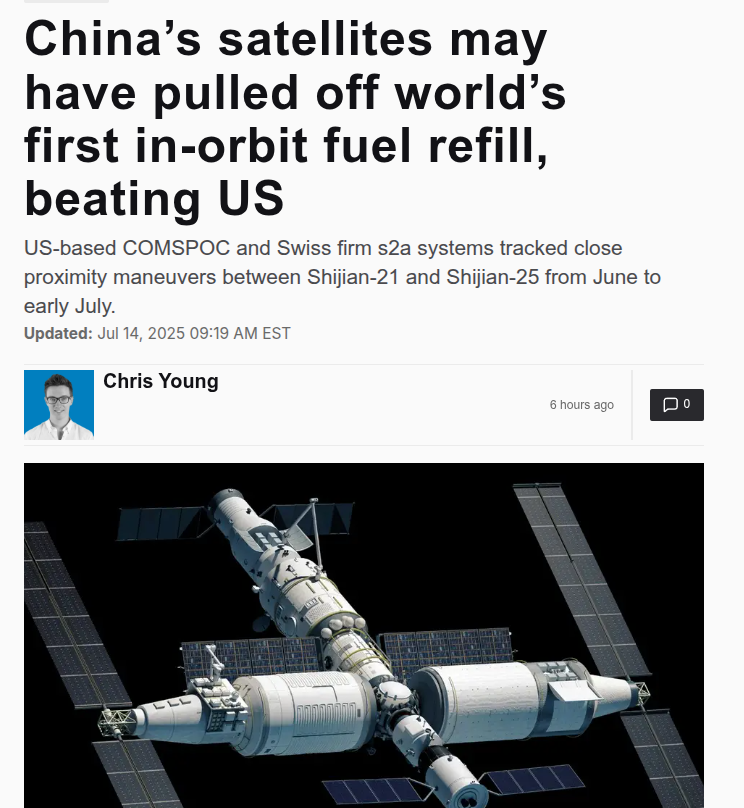[GUEST ACCESS MODE: Data is scrambled or limited to provide examples. Make requests using your API key to unlock full data. Check https://lunarcrush.ai/auth for authentication information.]  Rohan Paul [@rohanpaul_ai](/creator/twitter/rohanpaul_ai) on x 74K followers Created: 2025-07-14 22:49:05 UTC China just topped up a satellite’s fuel tank in space, the first time any nation has managed that. Shijian-25 pumped propellant into Shijian-21 while both cruised 35,786km above Earth. WHY ITS SO DIFFICULT? Pulling this off in geostationary orbit is super tricky because even tiny timing errors can send partners drifting kilometers apart. The pair used laser range finders, optical cameras, and micro-thrusters to match speed almost perfectly, then latched together with a probe-and-drogue port adapted for small buses. In weightlessness, liquid does not settle at the bottom, it floats and swirls. When Shijian-25 pumped propellant, that moving mass shifted the satellite’s center of gravity. Any shift changes the craft’s balance and can start a gentle tumble. The onboard computer watched for tiny wobbles and fired short, precisely timed bursts from the attitude-control thrusters. An attitude-control thruster is a small rocket motor on a spacecraft that nudges the craft around its center so antennas, cameras, or solar panels face the right direction. The onboard computer measures any unwanted wobble with gyros and star trackers, then fires these thrusters in very short pulses. Each pulse creates a tiny force, just enough to start or stop a slow spin without wasting much propellant. Each puff cancelled the unwanted motion before it built up. By nipping the wobble early, the computer stopped the craft from drifting into a larger, slow spin that would waste extra fuel and make docking riskier. The payoff is big. Fuel, not electronics, decides a satellite’s lifespan. A successful top-up can add years of service and save the launch of a replacement that can cost $200M or more. Also shows that China can handle precision servicing far from any crew, a skill long discussed but never proven in orbit until now. --- interestingengineering. com/space/china-refuels-satellites-in-earths-orbit  XXXXX engagements  **Related Topics** [china](/topic/china) [Post Link](https://x.com/rohanpaul_ai/status/1944891931781455980)
[GUEST ACCESS MODE: Data is scrambled or limited to provide examples. Make requests using your API key to unlock full data. Check https://lunarcrush.ai/auth for authentication information.]
 Rohan Paul @rohanpaul_ai on x 74K followers
Created: 2025-07-14 22:49:05 UTC
Rohan Paul @rohanpaul_ai on x 74K followers
Created: 2025-07-14 22:49:05 UTC
China just topped up a satellite’s fuel tank in space, the first time any nation has managed that.
Shijian-25 pumped propellant into Shijian-21 while both cruised 35,786km above Earth.
WHY ITS SO DIFFICULT?
Pulling this off in geostationary orbit is super tricky because even tiny timing errors can send partners drifting kilometers apart.
The pair used laser range finders, optical cameras, and micro-thrusters to match speed almost perfectly, then latched together with a probe-and-drogue port adapted for small buses.
In weightlessness, liquid does not settle at the bottom, it floats and swirls. When Shijian-25 pumped propellant, that moving mass shifted the satellite’s center of gravity.
Any shift changes the craft’s balance and can start a gentle tumble. The onboard computer watched for tiny wobbles and fired short, precisely timed bursts from the attitude-control thrusters.
An attitude-control thruster is a small rocket motor on a spacecraft that nudges the craft around its center so antennas, cameras, or solar panels face the right direction. The onboard computer measures any unwanted wobble with gyros and star trackers, then fires these thrusters in very short pulses. Each pulse creates a tiny force, just enough to start or stop a slow spin without wasting much propellant.
Each puff cancelled the unwanted motion before it built up. By nipping the wobble early, the computer stopped the craft from drifting into a larger, slow spin that would waste extra fuel and make docking riskier.
The payoff is big.
Fuel, not electronics, decides a satellite’s lifespan. A successful top-up can add years of service and save the launch of a replacement that can cost $200M or more.
Also shows that China can handle precision servicing far from any crew, a skill long discussed but never proven in orbit until now.
interestingengineering. com/space/china-refuels-satellites-in-earths-orbit

XXXXX engagements
Related Topics china